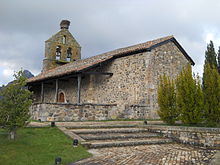Riaño (León)
| Riaño municipality | ||
|---|---|---|
 Riaño at the foot of the Picos de Europa
|
||
| coat of arms | Map of Spain | |

|
|
|
| Basic data | ||
| Autonomous Community : |
|
|
| Province : | Leon | |
| Comarca : | Concejo de Valdeburón | |
| Coordinates | 42 ° 36 ′ N , 6 ° 49 ′ W | |
| Height : | 1130 msnm | |
| Area : | 97.63 km² | |
| Residents : | 463 (Jan 1, 2019) | |
| Population density : | 4.74 inhabitants / km² | |
| Postal code : | 24900 | |
| Municipality number ( INE ): | 24130 | |
| administration | ||
| Website : | Riaño (León) | |
Riaño is a place and a municipality in northern Spain with 463 inhabitants (as of January 1, 2019) in the province of León in the autonomous community of Castile and León .
Location and climate
Riaño is located in the headwaters of the Río Esla on the north bank of the Riaño reservoir at the foot of the Picos de Europa at an altitude of about 1130 m ; the provincial capital León is about 100 km (driving distance) in a south-westerly direction. The climate in winter is harsh, but in summer it is rather dry and warm; Rain (approx. 795 mm / year) falls mainly in the winter half-year.
Population development
| year | 1857 | 1900 | 1950 | 2000 | 2017 |
| Residents | 1,810 | 2,025 | 1,849 | 627 | 477 |
Because by the mechanization of agriculture triggered and the abandonment of small farms rural exodus , the population of the former small town has fallen steadily since the beginning of the 20th century.
economy
For centuries, Riaño was a rural community whose residents provided themselves with food; only butter and cheese could be sold in markets, but they were all far away. Since the 1990s tourism has been of greater importance; several houses are rented out as holiday apartments (casas rurales) . In 2016, the Parque Regional de la Montaña de Riaño y Manpodre was established.
history
The old farming village of Riaño was the capital of a rural community made up of nine villages and hamlets (pedanías) . It was demolished in 1987 and sank in the reservoir; most of the hamlets - with the exception of Horcadas and Carande - have also perished or abandoned. The new place Riaño was gradually built in the 1980s.
Attractions

- The surrounding landscape is one of the most beautiful in northern Spain because of the mountain backdrop of the Picos de Europa . Numerous hiking trails have been developed.
- The Iglesia de Nuestra Señora del Rosario from the hamlet of La Puerta , which dates back to the 14th century but was largely built from rubble stones, was saved from the floods of the new reservoir and rebuilt on the outskirts of Riaño; only the bell gable (espadaña) consists of precisely hewn house stones . The portal is on the south side and is protected by a canopy resting on wooden supports. The nave is spanned by a wooden ceiling; the vaulted, but shallow apse shows joint paintings , crosses and a figure of a saint with a crook (St. Anthony); Opposite serpent creatures can be found in the upper part of the slightly pointed triumphal arch and in the painted vaulted ribs.
- An old granary ( horreo ) was also rebuilt.
- In 2004 the Museo Etnográfico Comarcal de Riaño was inaugurated, which offers insights into the long-gone world of life and work in the region.
Web links
Individual evidence
- ↑ Cifras oficiales de población resultantes de la revisión del Padrón municipal a 1 de enero . Population statistics from the Instituto Nacional de Estadística (population update).
- ↑ Riaño (León) - Climate tables
- ^ Riaño (León) - population development
- ^ Riaño (León) Museum





